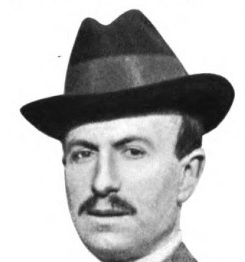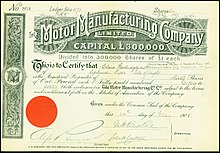
The Birmingham Small Arms Company Limited (BSA) was a major British industrial combine, a group of businesses manufacturing military and sporting firearms; bicycles; motorcycles; cars; buses and bodies; steel; iron castings; hand, power, and machine tools; coal cleaning and handling plants; sintered metals; and hard chrome process.

The Daimler Company Limited, before 1910 known as the Daimler Motor Company Limited, was an independent British motor vehicle manufacturer founded in London by H. J. Lawson in 1896, which set up its manufacturing base in Coventry. The company bought the right to the use of the Daimler name simultaneously from Gottlieb Daimler and Daimler-Motoren-Gesellschaft of Cannstatt, Germany. After early financial difficulty and a reorganisation of the company in 1904, the Daimler Motor Company was purchased by Birmingham Small Arms Company (BSA) in 1910, which also made cars under its own name before the Second World War. In 1933, BSA bought the Lanchester Motor Company and made it a subsidiary of the Daimler Company.

Horseless carriage is an early name for the motor car or automobile. Prior to the invention of the motor car, carriages were usually pulled by animals, typically horses. The term can be compared to other transitional terms, such as wireless phone. These are cases in which a new technology is compared to an older one by describing what the new one does not have.

Liquidation is the process in accounting by which a company is brought to an end in Canada, United Kingdom, United States, Ireland, Australia, New Zealand, Italy, and many other countries. The assets and property of the company are redistributed. Liquidation is also sometimes referred to as winding-up or dissolution, although dissolution technically refers to the last stage of liquidation. The process of liquidation also arises when customs, an authority or agency in a country responsible for collecting and safeguarding customs duties, determines the final computation or ascertainment of the duties or drawback accruing on an entry.
The Lanchester Motor Company Limited was a British car manufacturer in active trade between 1899 and 1955. Though the Lanchester Motor Company Limited is still registered as an active company and accounts are filed each year, the marque has been dormant since. As of 2014 it is marked as "non-trading".

Daimler-Motoren-Gesellschaft was a German engineering company and later automobile manufacturer, in operation from 1890 until 1926. Founded by Gottlieb Daimler (1834–1900) and Wilhelm Maybach (1846–1929), it was based first in Cannstatt. Daimler died in 1900, and their business moved in 1903 to Stuttgart-Untertürkheim after the original factory was destroyed by fire, and again to Berlin in 1922. Other factories were located in Marienfelde and Sindelfingen.

Salomon v A Salomon & Co Ltd[1896] UKHL 1, [1897] AC 22 is a landmark UK company law case. The effect of the House of Lords' unanimous ruling was to uphold firmly the doctrine of corporate personality, as set out in the Companies Act 1862, so that creditors of an insolvent company could not sue the company's shareholders for payment of outstanding debts.
The Daimler Manufacturing Company (DMFG), was a boutique American automaker company from 1898 to 1907. From 1888 to 1898, the company was known as the Daimler Motor Company (DMC), formed under a partnership between Gottlieb Daimler of Daimler-Motoren-Gesellschaft and William Steinway of piano manufacturer Steinway & Sons. Headquartered in Long Island City, Queens, New York City near Steinway's Astoria headquarters, the company sold Daimler motors for yachts and launches, and goods vehicles including buses and trucks. It built and sold a single automobile model, the original American Mercedes.
Wrongful trading is a type of civil wrong found in UK insolvency law, under Section 214 Insolvency Act 1986. It was introduced to enable contributions to be obtained for the benefit of creditors from those responsible for mismanagement of the insolvent company. Under Australian insolvency law the equivalent concept is called "insolvent trading".
The Garrard & Blumfield or Blumfield & Garrard was an English electric car manufacturer from 1894 to 1896. The company is presumed to have been founded by C. R. Garrard and T. W. Blumfield.

Henry John Lawson, also known as Harry Lawson, was a British bicycle designer, racing cyclist, motor industry pioneer, and fraudster. As part of his attempt to create and control a British motor industry Lawson formed and co floated The Daimler Motor Company Limited in London in 1896. It later began manufacture in Coventry. Lawson organised the 1896 Emancipation Day drive now commemorated annually by the London to Brighton Veteran Car Run on the same course.

Frederick Richard Simms was a German mechanical engineer, businessman, prolific inventor and motor industry pioneer. Simms coined the words "petrol" and "motorcar". He founded the Royal Automobile Club, and the Society of Motor Manufacturers and Traders.
The DaimlerChrysler–Mitsubishi alliance refers to the 69-month period during which U.S.-German automaker DaimlerChrysler AG (DCX) held a controlling stake in Mitsubishi Motors Corporation (MMC). First established on March 27, 2000, with the signing of a letter of intent, it was initiated by Jürgen E. Schrempp, the chairman of DCX, who was attempting to build what he called a "Welt AG" which would have as widespread a presence across worldwide automotive markets as its rivals. The merger with the Chrysler Corporation had increased Daimler-Benz's share of the North American market, and Mitsubishi Motors offered a gateway to Asia.

United Kingdom insolvency law regulates companies in the United Kingdom which are unable to repay their debts. While UK bankruptcy law concerns the rules for natural persons, the term insolvency is generally used for companies formed under the Companies Act 2006. Insolvency means being unable to pay debts. Since the Cork Report of 1982, the modern policy of UK insolvency law has been to attempt to rescue a company that is in difficulty, to minimise losses and fairly distribute the burdens between the community, employees, creditors and other stakeholders that result from enterprise failure. If a company cannot be saved it is liquidated, meaning that the assets are sold off to repay creditors according to their priority. The main sources of law include the Insolvency Act 1986, the Insolvency Rules 1986, the Company Directors Disqualification Act 1986, the Employment Rights Act 1996 Part XII, the EU Insolvency Regulation, and case law. Numerous other Acts, statutory instruments and cases relating to labour, banking, property and conflicts of laws also shape the subject.

Re Anglo-Austrian Printing & Publishing Union [1895] 2 Ch 891 is a UK insolvency law and company law case, concerning recovery of assets under a misfeasance action. It was held that because the claims were vested in the company before the company went into liquidation, the proceeds of such a claim would be caught by a floating charge where the floating charge was expressed to include any after-acquired property.

The Coventry Motor Company or CMC was a Coventry motor vehicle manufacturer established in early 1896 by H J Lawson's secretary Charles McRobie Turrell (1875-1923) as a subsidiary of Lawson's British Motor Syndicate.

The Great Horseless Carriage Company Limited was formed in May 1896 with a capital of £750,000 in shares of £10 each "of which £250,0000 was for working capital". The company was formed to carry on the horseless carriage industry in England and works with railway and canal adjoining were secured at Coventry. The rights that were purchased had little lasting value and after a number of financial reconstructions beginning in 1898 all activities were terminated by 1910.

The British Motor Syndicate Limited (BMS) was a company formed in November 1895 by company promoter and entrepreneur Harry John Lawson. Lawson's aim was to use BMS to raise funds from the public to establish a business with a monopoly on petrol-driven cars by acquiring as many patents as possible related to such vehicles from Gottlieb Daimler, his business associates, and other sources.
The Laycock Engineering Company Limited of Archer Road, Millhouses, Sheffield, Yorkshire, England was an engineering business established in 1884 by W S Laycock which made small and major components for railway rolling stock.

Re Yagerphone Ltd [1935] 1 Ch 392 was a United Kingdom insolvency law decision relating to unfair preferences and the proceeds of any claims by a liquidator for unfair preferences, and in particular determining the priority of claims between the general body of creditors and the holder of a floating charge.














